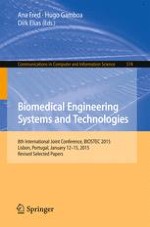2015 | Buch
Biomedical Engineering Systems and Technologies
8th International Joint Conference, BIOSTEC 2015, Lisbon, Portugal, January 12-15, 2015, Revised Selected Papers
herausgegeben von: Ana Fred, Hugo Gamboa, Dirk Elias
Verlag: Springer International Publishing
Buchreihe : Communications in Computer and Information Science
